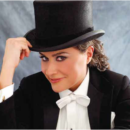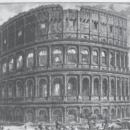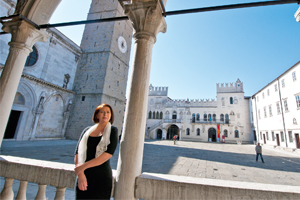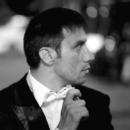
One Full Sunday of Art in Rome
H.E. Diego Brasioli, the Ambassador of Italy in Romania has the pleasure to share with us his interests in the art of the Eternal City. Diego Brasioli has been a diplomat for almost 30 years in Pakistan, Jordan and Lebanon, he was General Consul in Los Angeles and within the last years he was in charge of the G8 political agenda within the Ministry of Foreign Affairs. He was decorated by the President of the Republic with the Order Cavaliere Ufficiale dell’Ordine al Merito della Repubblica
A city like Rome offers a multitude of possibilities in the area of art. Ideally I would like to suggest a few examples of an easy itinerary that, through a comfortable walk, will give the possibility of capturing some of the deepest emotions the Eternal City can offer. Most of the pleasure we take out of our activities, depends on the time of the day we devote to them. I would therefore like to start my day, early on a Sunday morning, when the city is still half-asleep. Nothing beats the quiet elegance of Piazza Farnese with its palace designed by Michelangelo (which now hosts the French Embassy) and the music of the water running from the ancient Roman fountain.
A few steps from this jewel you can walk in Campo de’ Fiori, the oldest flower and vegetable open air market in Rome, and then to Piazza Navona, built on the site of the Stadium of Domitian, dating back from the 1st century AD. In the center of the square stands the famous “Fountain of the Four Rivers” by Gian Lorenzo Bernini, topped by the Obelisk of Domitian, and faced by the baroque church of Sant’Agnese, completed by Bernini’s archrival, Borromini.
The square is full of tourists from all over the world and skilled painters who offer to draw you a special portrait for a cheap price. Street musicians play in front of the coffee-shops around this square, that is arguably the real pulsating heart of the city; like two thousand years ago, Piazza Navona is the unique set of an ever-changing show of humanity.
At this point one deserves a good espresso, and there is no better place for that than the Caffé della Pace, one of the most charming coffee houses in town. And since it is just nearby, why not visit the Chiostro del Bramante, where one can enjoy art exhibitions in a peaceful environment?
I would then like to stroll along Via dei Coronari, with its antique shops, reaching Ponte Sant’Angelo. It is now noon, and across the river, past the castle which once was the mausoleum of the Roman Emperor Hadrian, I would continue to St. Peter’s Square just in time to attend, among thousands of pilgrims and faithful, the Pope’s sermon and blessing.
A light lunch at Caffé delle Arti is followed by a visit of GNAM (Galleria Nazionale d’Arte Moderna), in the heart of Villa Borghese, where one can admire the great work of Italian and international painters and sculptors from the 19th and 20th centuries, with names such as Antonio Canova, Francesco Hayez, Giovanni Fattori, Silvestro Lega, Domenico Morelli, Vincent Van Gogh, Claude Monet, Paul Cezanne, Giuseppe De Nittis, Filippo Marinetti, Giovanni Boldini, Giacomo Balla, Giacomo Manzú, Giorgio Morandi, Giorgio De Chirico, Arturo Martini, Lucio Fontana, Giuseppe Capogrossi, Alighiero Boetti, and many others. The museum lies in Villa Borghese, one of the largest parks in Rome, an area which started as a vineyard in the sixteenth century. Following the instructions of Car dinal Scipio Borghese, the greatest art collector of the time, landscaper Domenico Savino da Montepulciano designed a very formal park with geometric shapes, the first such park in Rome. A villa was built by the architect Flaminio Ponzio after a sketch by the cardinal himself. At the end of the eighteenth century an artificial lake was created in the middle of the park. A small Ionic temple was also built on the island in the lake. It is dedicated to Aesculapius, the god of healing. The eighty hectare large park now features wide shady lanes, several temples, beautiful fountains and many statues.
A pleasant walk trough the Villa Borghese (enjoying a tasty gelato, if you wish), will bring us to the Pincio terrace, where we can admire the unique view of Rome caressed by the sunset, and then down to Piazza di Spagna trough Trinitá dei Monti, again in the heart of the city.
The evening has even more to offer. I can think of a theater show at Teatro Argentina -right in front of the archeological area that hosts four Republican Roman temples and the remains of Pompeius Theatre (this is the very place where Julius Caesar is believed to have been assassinated).
Another possibility is the opera or an organ concert – usually free of charge -in one of the churches of the center, such as Sant’Ignazio. Here Andrea Pozzo in 1685 painted the largest trompe-l’oeil in the world, a grandiose fresco that stretches across the nave ceiling. Pozzo worked to open up, even dissolve the actual surface of the nave’s barrel vault illusionistically, arranging a perspective projection to make the observer see a huge cupola (dome), open to the bright sky, and filled with upward floating figures.
The day will then be complete with a late candle-lit Italian dinner in the spectacular terrace of Grand Hotel de la Minerve, which offers an incomparable view of the main monuments of the city. A touch of magic at the end of a special day.









